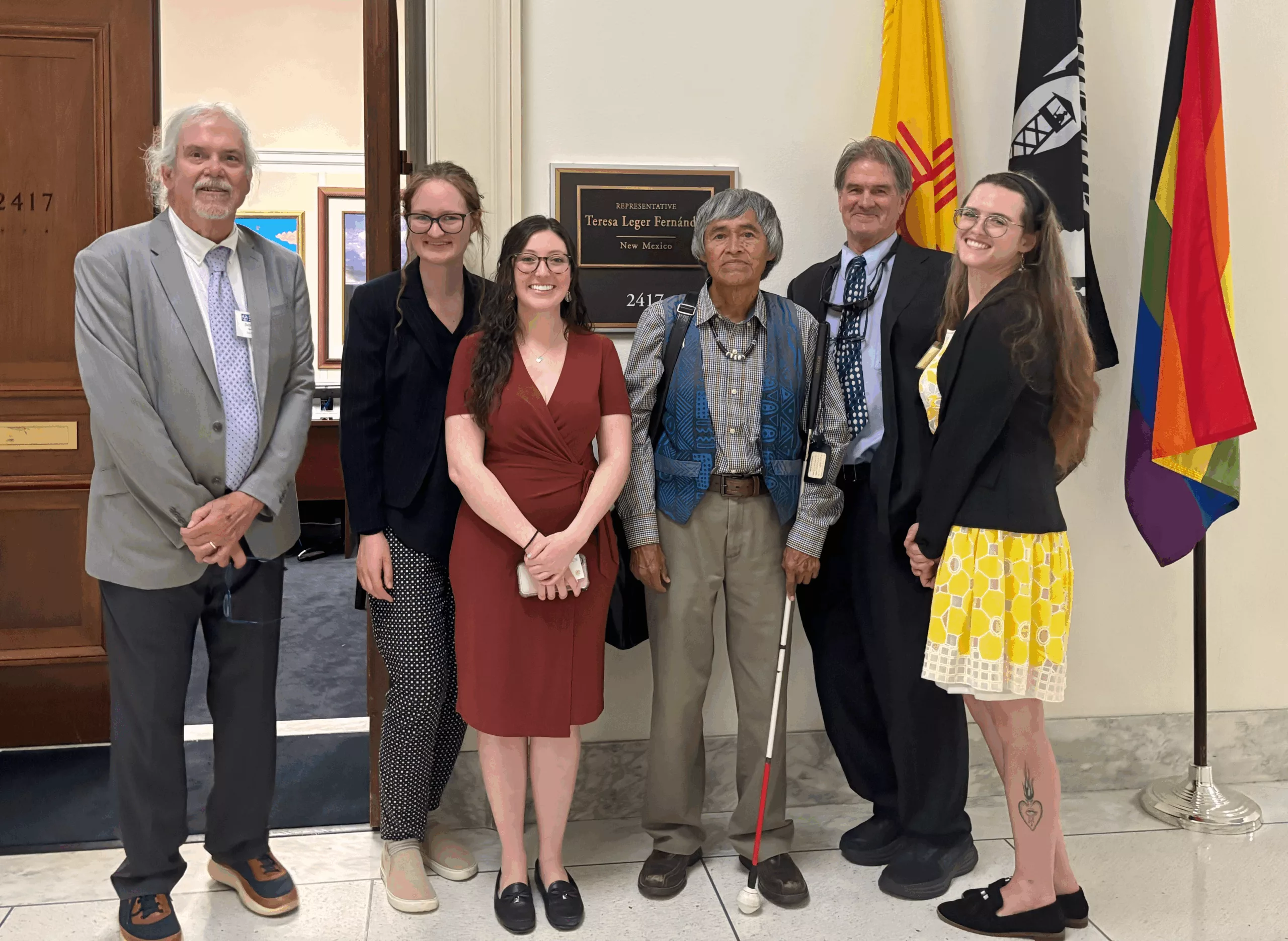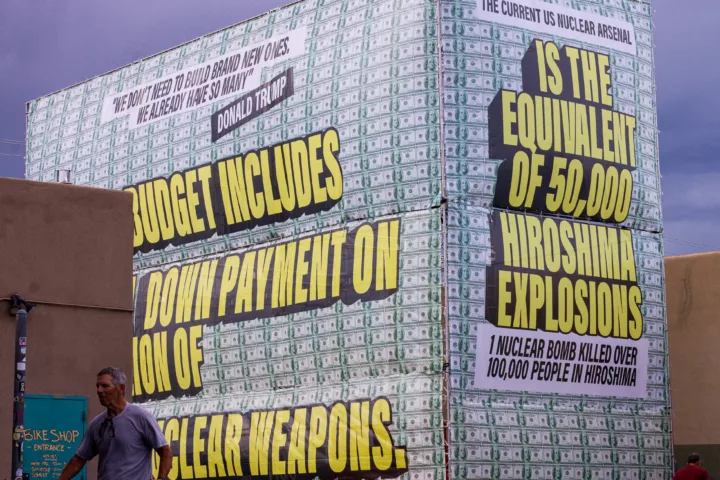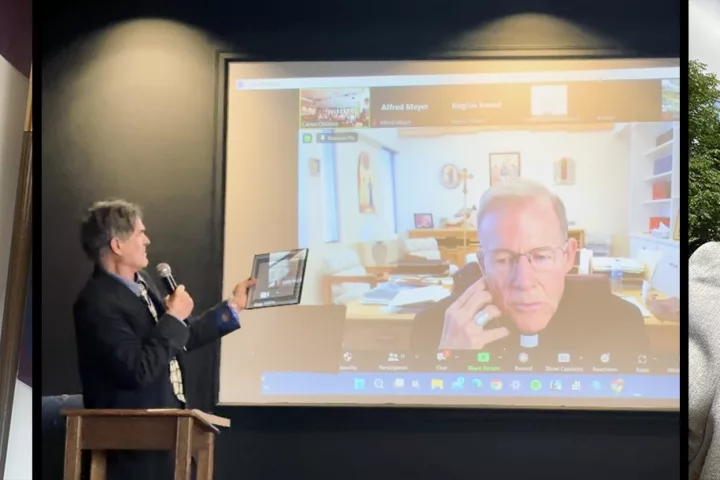Your Nuclear Watch New Mexico team has just returned from a weeklong trip to Washington D.C. (we went so you don’t have to!). The Alliance for Nuclear Accountability (ANA) hosts an annual “DC Days” conference and following Spring Meeting, and we proudly joined as part of a record number of groups this year. Over 60 individuals from 30+ organizations journeyed to DC to lobby congress on nuclear weapons, energy, and waste policy on behalf of the frontline nuclear communities we represent. Members were present from groups representing the entire U.S. nuclear complex, including sites in Georgia, New Mexico, Tennessee, California, Missouri, Colorado, Idaho, Nevada and beyond. NukeWatch NM brought all three staff members—Jay Coghlan, Scott Kovac, and Sophia Stroud (whose participation was made possible by a youth scholarship from ANA)—to participate in DC Days and the subsequent two-day spring meeting. The ANA DC Days schedule included over 70 meetings with senators, representatives, and other relevant agencies, such as the Department of Energy, the Government Accountability Office, and the Defense Nuclear Facilities Safety Board. Our NukeWatch team attended nearly 30 of these meetings. The Alliance for Nuclear Accountability put together a new report to present our “asks” to congress as a coalition, including analysis and recommendations for nuclear weapons, nuclear waste, and nuclear energy policy and funding. Please click HERE for the full report, and HERE for a short summary.
I was glad to see increased representation from Nevada this year, and especially Indigenous representation. In light of the current administration’s attacks on Environmental Justice, it is more important than ever that ANA as a whole, as well as individual member groups, continue to prioritize uplifting Native American voices, not only because of their deep cultural, spiritual, and social connections to the land, including sacred sites and traditional knowledge essential to religious freedom and access, but also because of the violent legacy and ongoing reality of nuclear colonialism, in which Indigenous lands and peoples have been deliberately and disproportionately targeted in the nuclear industry with uranium mining, nuclear weapons testing and production, and the disposal of radioactive waste. To learn more about Nuclear Colonialism, see: www.networkadvocates.org/downwinders and read Nuclear Nuevo México: Colonialism and the Effects of the Nuclear Industrial Complex on Nuevomexicanos by Myrriah Gómez.
The Alliance tries to coincide this conference with the annual release of the upcoming year’s budget, however the FY 2026 DOE Budget was released woefully late this year, and we had to author the report still using FY25 figures. By the time we actually arrived in DC on June 8, only a FY26 “Budget in Brief” had been released from DOE, which is all we had to work with during our lobbying (by law the annual Congressional Budget Requests are due the first Monday every February). As a baseline, 65% of the Department’s proposed $46 billion budget is earmarked for its semi-autonomous nuclear weapons agency, the National Nuclear Security Administration (NNSA). In turn, more than 80% of NNSA’s proposed FY 2026 funding is for its nuclear weapons research and production programs, with a 25% funding increase over FY 2025. To complicate things further, the Trump Administration is adding another $4.8 billion from so-called “reconciliation” funding, bringing NNSA’s “Total Weapons Activities” to just under $30 billion. Taken together, this is a 53% increase above FY 2025 for NNSA’s nuclear weapons research and production programs. To help pay for this, nonproliferation and cleanup programs are being cut by 5%, science by 14%, cybersecurity and emergency response by 25%, and energy efficiency and renewable energy programs by 74%.
After spending more than $215 billion on cleanup over the past 35 years, the federal government says that 16 sites in 12 states will require decades more cleanup that will cost at least $675 billion more. Most of DOE’s environmental liabilities are managed by the Environmental Management (EM) program, which addresses the legacy of contamination from the nuclear weapons complex. This includes managing thousands of contaminated facilities formerly used in the nuclear weapons program, overseeing the safe management of large quantities of radioactive waste and nuclear materials, and cleanup of large volumes of contaminated soil and water. The DOE EM program is approaching $900 billion in estimated life-cycle costs. Yet, DOE cut this funding for FY 2026 and requested only $8.09 billion for cleanup. DOE chronically under-requests funding for cleanup, in contrast to weapons production spending.
Our argument for comprehensive cleanup of nuclear wastes sites across the U.S. is that by investing more taxpayer dollars in cleanup, Congress can reduce long-term costs and protect the health of future generations. It is time to stop paying contractors to babysit waste sites. Dramatically increased, well-managed spending on cleanup in the next few years will save billions in the future, and will protect the health of workers and the public. We want more cleanup, less shortcuts. The estimated environmental liabilities include the versions of cleanup that DOE can justify while leaving much of the wastes behind. For instance, DOE’s preferred alternative for an estimated $12 million cleanup of Materials Disposal Area C, at Los Alamos National Laboratory, is to cap-and-cover the 11.8 acre site. This would leave the wastes above the regional aquifer forever. However, the New Mexico Environment Department is requiring complete excavation of Area C at an estimated cost of $805 million. That’s $790 million more than DOE has in its current estimate. We are continuing to support the Environment Department in this matter; DOE will likely end up suing the Environment Department to try and get cap-and-cover instead of doing the right thing. This is just one example of how the Environmental Management (EM) budget needs dramatic increases in annual cleanup funding.
Besides advocating for comprehensive nuclear waste cleanup, our priority was cutting funding for expanded plutonium pit production. Plutonium pit production is the number one issue in for the so-called “modernization” of nuclear weapons, and has implications for the rest of the weapons production chain including two new warhead designs. This $2 trillion modernization is basically an extreme makeover of the entire US nuclear force. Starting with the National Nuclear Security Administration, it’s a plan to rebuild every single warhead while giving them new military capabilities. Now it’s for completely new designs, and that’s what pit production is all about. The take-home point: NO pit production is to maintain the safety and reliability of the existing stockpile. ZERO. It’s for future designs only. They also can’t test these new designs (remember the Oppenheimer movie, which was completely about the test of the world’s first plutonium pit?) because of the existing international testing moratorium. Conversely, it could pressure the US to return to testing – we know, for example, that a former national security advisor for trump has already explicitly argued for the resumption for testing. Needless to say, if the US started testing, other countries could start to test as well.
In 2006, independent experts concluded that pits last at least 85 years (their average age is now ~42). At least 15,000 existing pits are already stored at the Pantex Plant near Amarillo, TX. Unneeded pit production is extremely expensive (approximately $60 billion over the next 25 years – the most expensive program the National Nuclear Security Administration (NNSA) has to date). Nevertheless, NNSA has no credible cost estimates or an “Integrated Master Schedule” recommended by the independent Government Accountability Office. The SRS pit plant is slated to cost up to $30 billion, making it the second most expensive building in history! In September 2024, a federal judge ruled that the NNSA had violated the National Environmental Policy Act by not completing a new programmatic environmental impact statement (PEIS) on expanded plutonium pit production.
As stated, nuclear waste cleanup and plutonium pit production are current priorities for us here at Nuclear Watch New Mexico, but these are just two items among countless others on the ANA agenda (honorable mention: nuclear energy and “small modular” or “advanced” reactors). We also worked hard on supporting the Defense Nuclear Facilities Safety Board (DNFSB or Board), asking Congress to help DNFSB maintain quorum. This requires Republicans on the Senate Armed Services Committee recommend a Presidential nomination of at least one new Board Member that the Senate approves. Better still would be three Senate-approved nominees (two Republicans and one Democrat), bringing the Board to full membership. See this recent article about this ANA work here: www.exchangemonitor.com/safety-watchdog-board-needs-a-quorum-citizen-groups/. We are also advocating for this on a local level here in New Mexico, so please stay tuned for more information, and hopefully good news come October.
I was a team leader for two meetings, which can be a high-pressure position, but my confidence in my abilities in this role grow every year. My knowledge has grown significantly, but this year I also came to realize that the true value of a team leader isn’t necessarily to serve as a repository of all the facts, but really to bring structure, cohesion, and thoughtful curation to the meeting, and importantly, to be a support system for other ANA members participating. This DC Days in general felt lighter and easier than ever, as I was really able to focus on these kinds of elements now that I truly feel I have a real handle on the facts and science, and solid background in the issues. These are some of the most complex issues of all time, but now is a crucial moment to be involved. Speaking truth to power is one of the most important, impactful, and grounded ways to achieve our admittedly tall order for global peace and nuclear disarmament.



